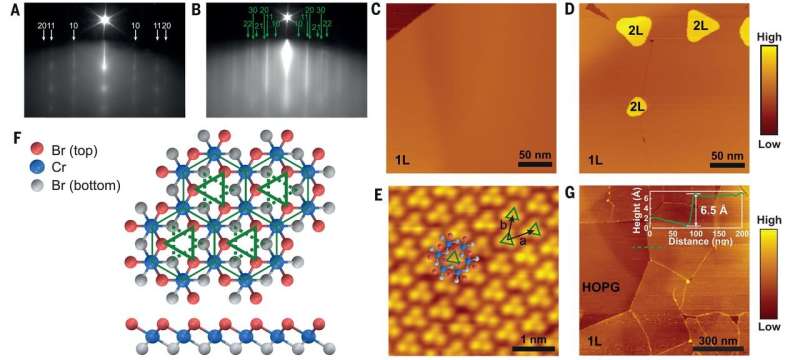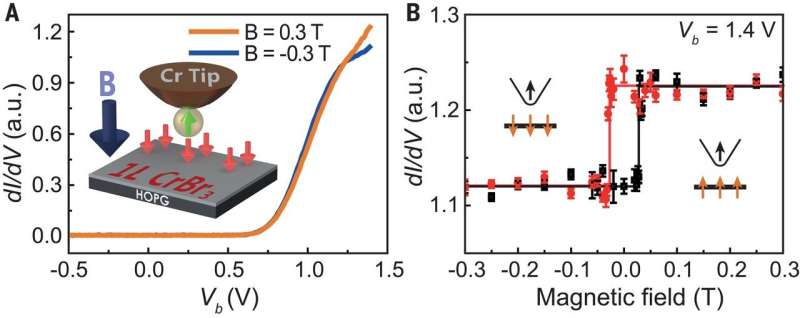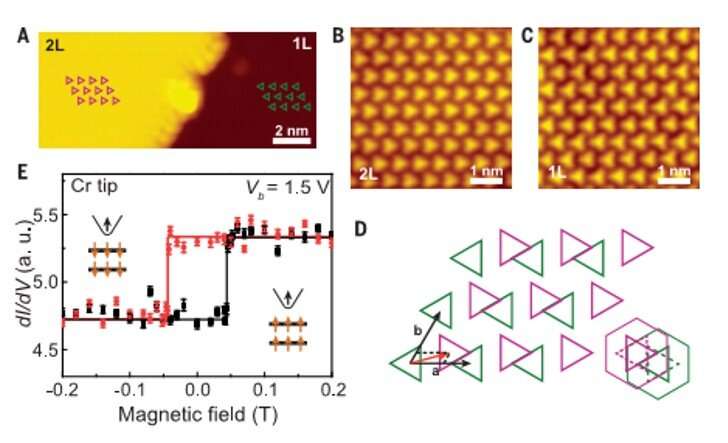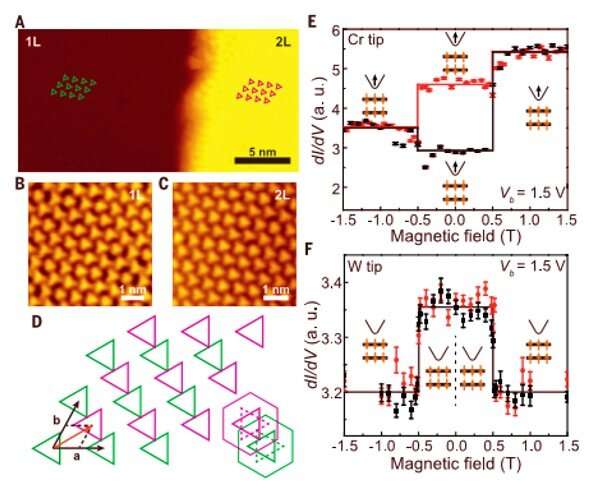Molecular beam epitaxy (MBE) Growth of CrBr3 monolayer and bilayer on HOPG (highly oriented pyrolytic graphite). (A and B) RHEED (reflection high-energy electron diffraction) patterns with indicated diffraction orders of (A) the bare HOPG substrate and (B) the MBE-grown CrBr3 film. (C and D) STM (Scanning Tunneling Microscopy) images of (C) the CrBr3 monolayer with (D) bilayer islands. The scan parameters were as follows: Vb = 1.1 V, I = 100 pA, T = 5 K for (C) and Vb = 1.5 V, I = 100 pA, T = 5 K for (D). (E) Atomically resolved image of a monolayer CrBr3 with an overlaid atomic structure. The scan parameters were as follows: Vb = 1.5 V, I = 500 pA, T = 5 K. The lattice constants were determined to be 6.3 Ǻ for the primitive vectors a and b, consistent with the bulk values. (F) Illustrations of the top and side views of the monolayer CrBr3 atomic structure. The Cr atoms form a honeycomb lattice sandwiched by Br atoms. Within the Cr honeycomb lattice, the top and bottom surfaces of Br atoms form single triangles but with opposite orientation, indicated by solid and dotted green lines, respectively. (G) AFM image of monolayer CrBr3 with partial coverage. A line-cut profile across the monolayer and bare substrate is shown with a monolayer height of ~6.5 Ǻ. Credit: Science, doi: 10.1126/science.aav1937
Materials scientists aim to control the crystal structure of a solid—in a powerful approach to manipulate their fundamental properties. Researchers can achieve this control in van der Waals (vDW) materials by modifying the stacking order through rotation and translation between the vDW layers. In a recent study published in Science, Weijong Chen and a research team in the interdisciplinary departments of physics, advanced materials, nanoelectronics devices and quantum computing, and materials science and engineering in China and the U.S. observed stacking-dependent interlayer magnetism in the two-dimensional magnetic semiconductor chromium tribromide (CrBr3).
They achieved this through the successful growth of a monolayer and bilayer of the material using molecular beam epitaxy (MBE). The researchers used in situ spin-polar scanning tunneling microscopy and spectroscopy to directly correlate the atomic lattice structure with the observed magnetic order. They observed the individual monolayer of CrBr3 to be ferromagnetic but the interlayer coupling in the bilayer depended on the stacking order to either be ferromagnetic or antiferromagnetic. Observations made in the work will pave the way to manipulate 2-D magnetism with layer twist angle control.
Understanding the type of van der Waals (vdW) stacking is critical to determine the properties of layered vdW materials. Weak interlayer vdW interactions can allow scientists to control rotational and translational degrees of freedom between layers to create a host of new materials with distinct stacking symmetries and functionalities. While previous work focused on the electronic and optical properties of vdW stacking, scientists have made recent discoveries of magnetism in two-dimensional materials using mechanical exfoliation and molecular epitaxy techniques. Among the newly discovered 2-D magnetic materials, the family of chromium trihalide CrX3 (where X can be chlorine, bromine or iodine) have received great attention. Such magnetic structures can lead to a number of emerging phenomena including giant tunneling magnetoresistance, electrical control of 2-D magnetism and giant non-reciprocal optical second-harmonic generation.
Spin-polarized tunneling of monolayer CrBr3. (A) Spin-polarized tunneling spectra under positive and negative out-of-plane magnetic fields (±0.3 T). The inset illustrates the experimental geometry. The magnetization at the tip apex is assumed to be spin up (B) dI/dV signal as a function of the magnetic field. Vb was fixed at 1.4 V. The out-of-plane magnetic field was swept upward (black data) and downward (red data). The ferromagnetic hysteresis loop is outlined as rectangular solid lines. Insets sketch the two configurations of the magnetization alignment between the Cr tip and the monolayer CrBr3 film. The in-plane component of magnetization at the Cr tip apex, if any, does not contribute to the magnetic contrast in dI/dV. Credit: Science, doi: 10.1126/science.aav1937
In contrast to chromium triiodide (CrI3), researchers found the interlayer coupling in atomically thin chromium tribromide (CrBr3)to be ferromagnetic. In the present work, Chen et al. therefore used in situ spin-polarized scanning tunneling microscopy and spectroscopy to establish a direct correlation between the interlayer magnetic coupling and stacking structures in CrBr3. The team initially grew CrBr3 films on freshly cleaved, highly oriented pyrolytic graphite (HOPG) substrates using molecular beam epitaxy (MBE). They monitored the sample surface during growth in situ with reflection high-energy electron diffraction (RHEED). The stripe-like RHEED patterns confirmed a 2-D crystalline monolayer thin film of CrBr3, which Chen et al. verified using scanning tunneling microscopy.
On further deposition, the materials scientists enabled bilayer CrBr3 islands to form as periodically spaced triangular clusters. The crystal structure of the CrBr3 molecule contained Cr atoms arranged in a honeycomb lattice, surrounded by an octahedron of six Br atoms. They determined the thickness of the monolayer to be 6.5 Angstrom (Å) using atomic force microscopy (AFM). Both large-scale topography (surface geometry) and atomically resolved STM images showed high-quality growth of the CrBr3 monolayer films. The team measured magnetic properties of the thin film using spin-polarized STM measurements and additionally confirmed the existence of ferromagnetism. For this, Chen et al. measured a series of tunneling spectra (dI/dV) by sweeping the magnetic field back and forth. The observation suggested that epitaxial CrBr3 monolayers grown on HOPG (highly oriented pyrolytic graphite) maintained semiconductor ferromagnetic properties. After confirming the atomic structure and ferromagnetism of monolayer CrBr3, Chen et al. focused on the CrBr3 bilayer.
Interlayer ferromagnetic-coupling in an H-type stacked bilayer CrBr3. (A) STM image of a CrBr3 film with both a monolayer (1L) region and a bilayer (2L) island. (B and C) Magnified, atomically resolved images of (B) the bilayer region and (C) its extended bottom monolayer at Vb = 1.9 V, indicating that the top and bottom layers in the bilayer are anti-aligned, or rotated by 180° (H-type stacking). (D) Atomic structure of the bilayer CrBr3, as determined from atomically resolved STM images. The unit cells of the top and bottom layers are represented by the magenta and green solid triangles, respectively, corresponding to the top surface of Br atoms in each monolayer sheet. These magenta and green solid triangles are also overlaid on the monolayer and bilayer in (A). The unit cell of the top layer (magenta) is a translation by 0.55a + 0.20b of the bottom layer (green). For comparison with the structures in table S2, the stacking structure is also shown with the bottom surface of Br atoms of each monolayer sheet as dotted triangles and the Cr atoms as solid hexagons. (E) Spin-polarized tunneling on the bilayer CrBr3 as a function of magnetic field with a Cr tip at Vb = 1.5 V. The out-of-plane magnetic field was swept upward (black data) and downward (red data). Like that of the monolayer CrBr3, a rectangular ferromagnetic hysteresis loop was observed with a coercive field of ~45 mT. Insets depict two configurations of the magnetization alignment between the tip and the sample. Credit: Science, doi: 10.1126/science.aav1937
In the MBE-grown bilayers, the scientists observed H- and R-type stacking structures, where the R-type maintained both layers aligned in the same orientation while the H-type allowed 180-degree rotation between the bilayers. The structural alignments gave rise to distinct interlayer magnetic coupling. For instance, in H-type stacked bilayer CrBr3, the interlayer coupling was ferromagnetic. Whereas the R-type stacked bilayer showed antiferromagnetically coupled behavior in its ground states giving rise to two additional configurations of magnetization. On further examination of interlayer coupling, the scientists observed the two-plateau behavior to demonstrate magnetic field-driven transition from antiferromagnetic to ferromagnetic character.
In this way, the scientists demonstrated distinct interlayer magnetism of the MBE-grown bilayer CrBr3 from antiferromagnetic coupling in R-type stacking to ferromagnetic coupling in H-type stacking to indicate the broad tunability of magnetism across the stacking orders of 2-D materials. Chen et al. credited the interlayer coupling in bilayer CrBr3 to superexchange interaction controlled by directional hybridization between p-orbitals of bromine (Br) and d-orbitals of chromium (Cr). Since the bond angles and bond distance of the Cr-Br-Br-Cr exchange path strongly depended on the stacking order, they expect the interlayer magnetism to depend on the interlayer distance and atomic site position relative to the specific stacking structure.
Interlayer antiferromagnetic coupling in an R-type stacked bilayer CrBr3. (A) STM image of a CrBr3 film with both a monolayer (1L) region and a bilayer (2L) island. (B and C) Atomically resolved images of (B) the monolayer and (C) the bilayer. Vb = 1.9 V. The stacking configuration in the bilayer is identified as R-type, i.e., the top and bottom layers are in the same orientation. (D) Atomic structure of the bilayer CrBr3, as determined from atomically resolved STM images. The unit cell of the top layer (magenta) is translated by 0.48a + 0.48b from the bottom layer (green). (E) Spin-polarized tunneling on an R-type stacked bilayer CrBr3 with a Cr tip at Vb = 1.5 V. The insets show four magnetization configurations, including the Cr tip and bilayer CrBr3, corresponding to different magnetic field–dependent dI/dV plateaus. The out-of-plane magnetic field was swept upward (black data) and downward (red data). (F) Spin-dependent tunneling on the bilayer CrBr3 in (C) with a nonmagnetic W tip at Vb = 1.5 V. Abrupt decrease of the dI/dV signal was observed at magnetic fields of ~±0.5 T, suggesting an interlayer antiferromagnetic coupling within ±0.5 T. Credit: Science, doi: 10.1126/science.aav1937.
While the exact growth mechanisms remain to be investigated, Chen et al. illustrated the importance of polytypism (polymorphism or variety) in vDW materials and its role in 2-D magnetism. The new work calls to closely examine stacking structures in mechanically exfoliated CrX3 samples to understand the distinctly observed properties of interlayer magnetic coupling. The researchers expect the work principle to manipulate 2-D magnetism by engineering unique spatially dependent spin textures for a variety of applications with vDW materials.
More information: Weijong Chen et al. Direct observation of van der Waals stacking–dependent interlayer magnetism, Science (2019). DOI: 10.1126/science.aav1937
Yuwei Shan et al. Stacking symmetry governed second harmonic generation in graphene trilayers, Science Advances (2018). DOI: 10.1126/sciadv.aat0074
Tao Jiang et al. Valley and band structure engineering of folded MoS2 bilayers, Nature Nanotechnology (2014). DOI: 10.1038/nnano.2014.176
Journal information: Science , Science Advances , Nature Nanotechnology
© 2019 Science X Network



























